
STX Turboforce II 4000 Series Quad Air Cooled Electric Meat Grinder
As some of you may know, in order to have a margarine/butter like spread, I end up rendering my own lard and tallow from pork leaf lard and beef suet, respectively, and I use my home rendered lard often in my baking as I don’t have a safe shortening. I’d been using a KitchenAid meat grinder attachment on my stand mixer to grind the pork leaf lard and suet, which is great for regular, normal occasional meat grinding, but I’m not regular or normal anymore. I pushed it a little too hard with the suet (which is very solid and waxy at room temperature) and cracked the plastic housing. It still works (yay KitchenAid!) and I can use it with the vegetable strainer for apple sauce and tomato sauce just fine, but I thought maybe it was time to stop tempting fate and get a real meat grinder. My KitchenAid is only 30+ years old, and I want it to keep plugging.
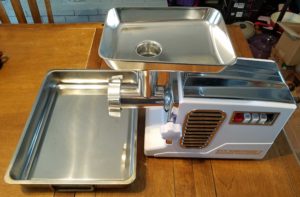
So I bought the STX Turboforce II 4000 Series Quad Air Cooled Electric Meat Grinder in December of 2017. This model now appears to be unavailable on Amazon and sold out on the manufacturer’s website (no affiliation with either), but there are other models available. I meant to do this review last summer, but you all know how that goes. I used it to grind pork leaf lard before rendering it in crock pots (grinding it helps with clean up exponentially, just cubing it is a disaster to scrub off the crock pots). I used it to grind pork liver up to mix with ground pork to make pork liver meatballs. But both pork leaf lard and pork liver are pretty easy to grind, so I felt like I hadn’t really had a fair test yet. I needed to grind something a little tougher.
Frankly, as someone with a corn allergy, buying ground meat is really not a good idea. There’s just an exponential increase in the chances for corn contamination due to the cleaners and sanitizers used on the grinders, and on the meat itself (see article where they allow ammonia gas to be puffed on the meat). And even if I get ground beef from what I consider a reputable source that would not use “lean finely textured beef” with puffs of ammonia gas on it, I’m still risking cross contamination from cleaners since I don’t have safe commercial products I can use. So now that the USDA is allowing “lean finely textured beef” to be classified “ground beef,” I’ve finally hit my threshold. It was time to face reality and let the convenience of pre-ground meat go.
When I used up my last package of ground beef from a store in the freezer, I decided it was time to give the meat grinder a workout. I purchased 12 pounds of chuck roast, and 2 pounds of suet to make sure I had a sufficient fat ratio. You need some fat to have a decent tasting burger. I cut everything up into 1 inch chunks. spread them to a single layer on sheet pans, and threw them in the freezer for an hour. It’s also a good idea to throw the grinder head pieces, the worm, the blade, grind plate, in the freezer too so that they are very cold when you start grinding. I didn’t do this for the beef, but it really helped with grinding pork. On high, I was able to grind all 14 pounds within 20 minutes. I carefully interspersed the suet with the meat so it would be mixed in.
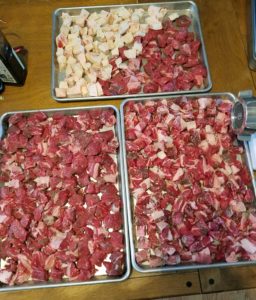
When I decided to go ahead and do some ground pork to have on hand to use in recipes and so I can eventually make some sausage, I used a Boston butt, a fresh picnic ham/pork shoulder, and some fatback I had in the freezer. Once I had thawed them out in the fridge for a few days, I skinned the picnic ham and boned the Boston butt and picnic ham, and cut the pieces into 1 inch chunks, following the same procedure as I did for the ground beef, and putting the grinder head pieces in the freezer with the chunks beforehand. On high, I ground what ended up being 13 and half pounds in less than 20 minutes.
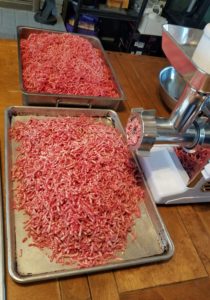
I’ve been fairly impressed with the ease of use, and it has very little left in the worm at the end. It’s a workhorse and for me, that’s important. I know that most people would grind their meat as they use it, but I don’t have time for that. I’m going to grind a ton at once and package it in one pound increments in the freezer, because then I’m only grinding once, and cleaning the meat grinder once. I’m sure most of our regular readers have guessed, but I’m all about economies of scale.
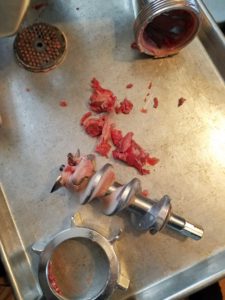
My only quibbles are that it is loud, the grinder head is not dishwasher safe as it’s aluminum and would discolor, and that it has to be hand washed and dried immediately for the same reason. The foot pedal is a nice option, so that you can operate hands free and not get meat all over the push buttons. I haven’t used the sausage stuffing tubes or the kubbe/kibbe attachments, as I’ve not yet found safe casings, and most kubbe recipes contain wheat. Maybe I’ll work on sourcing safe casings this summer, in between gardening, food preservation, and soap making (or it’ll get put off again, hahaha).
The verdict: Great machine for me, might be too much for most users.
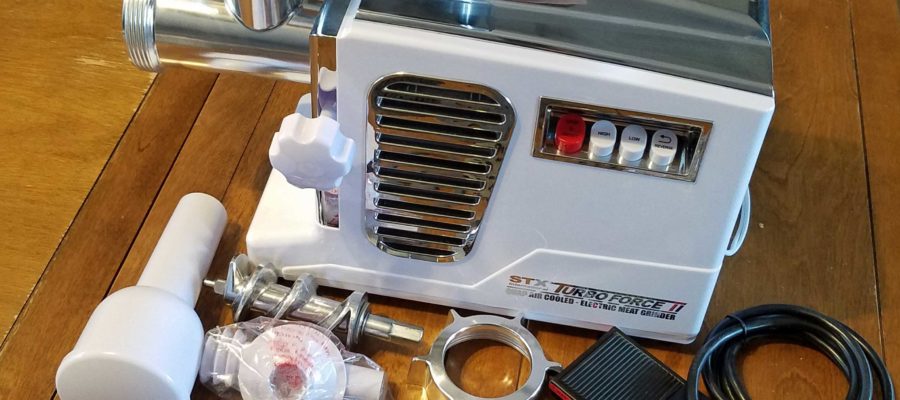
Leave a Reply